Yves GARY Hits: 10078
Category: SHAMROCK V
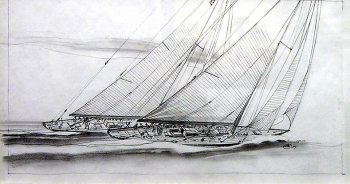 The fifth and final Challenger of Sir Thomas Lipton
The fifth and final Challenger of Sir Thomas Lipton• 1929 : Sir Thomas Lipton, owner of Lipton Tea, decides to challenge for the America's Cup for what will be his fifth and final time. He commissions naval architect, Charles E. Nicholson with the task of designing Shamrock V. She is built at Camper and Nicholson Shipyard in Gosport, UK.
Shamrock V is the first J-Class yacht to be commissioned and built in the UK. She is constructed of teak planking over steel frames and sports a hollow spruce spar.
• 1930 : Shamrock V is launched on 14 April with a full compliment of thirty one crew members. She participates in and wins fifteen of twenty two regattas prior to crossing the Atlantic under a modified sail plan for the America's Cup Challenge.
Shamrock V is entered as the Royal Ulster Yacht Club's challenger to the fourteenth America's Cup. The event is hosted by the New York Yacht Club and is comprised of a seven race series in the waters off Newport, RI. Four potential defenders are built to compliance with the J-Class rule and raced against one another in the USA, Weetamoe, Yankee, Whirlwind and Enterprise. Enterprise is victorious in the series and goes on to represent the NYYC against Shamrock V in the 1930 America's Cup.

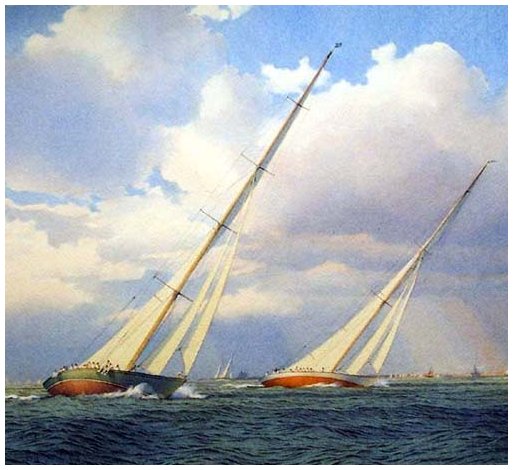 - From 13 to 18 September 1930, at Newport.
- From 13 to 18 September 1930, at Newport.
- The match shall be decided by the best four out of seven races.
- The time of the starting signal shall be taken as the time of the start of both yachts.
- Starting signals to be given at 11:30 o'clock; the warning signal to be fired ten minutes before starting signal, and the preparatory signal five minutes before.
- time limit for races five and a half hours.
- the first, third and fifth races to be to windward and leeward, the second and fourth over a triangle, all courses to be thirty miles, and laid to windward when possible.
- There shall be no time allowance.
Shamrock V is confronted to Enterprise, the defender of the New York Yacht Club.
Enterprise beat Shamrock V four wins to nil.
- September 13, 1st race, 30 miles, windward-leeward : Enterprise beat Shamrock V by 2 mn 52 s.
- September 15, 2nd race, 30 miles, triangle : Enterprise beat Shamrock V by 9 mn 34 s
- September 17, 3rd race, 30 miles, windward-leeward : Shamrock V abandoned on accident. Enterprise ends in 3 h 54 mn 16 s.
- September 18, 4th race, 30 miles, triangle : Enterprise beat Shamrock V by 5 mn 44 s.

• 1931 : After Sir Thomas Lipton's death late that year Shamrock is sold to aviation designer and magnate, Sir Thomas Sopwith, founder of Sopwith Aviation Company. Sopwith makes changes to her keel and rig configuration.
• 1932 : Sopwith campaigns Shamrock in and wins the Big Boat Class racing circuit that year.
• 1933 : Sopwith campaigns Shamrock in the south of England to better acquaint himself with the nuance of the J-Class. Sopwith challenges for the Cup and uses the experience to design Endeavor.
After completing his design of Endeavor, Sopwith sells Shamrock to an aviation friend, Sir Richard Fairey.
Fairey races Shamrock in the Big Boat Class racing circuit and comes in second to Velsheda. Shamrock's Wild Voyage, written by Irving Johnson is published by Milton Bradley. The book describes in detail Johnson's experiences sailing Shamrock home from her America's Cup debut in the USA.
• 1934-1936 : Sir Richard campaigns Shamrock with King George V and sails with distinction against Endeavor in the Big Boat Class.
• 1937 : Italian senator and publishing giant, Mario Crespi, buys Shamrock and moves her to Italy. In accordance with Italian maritime law he gives her an italian name. Shamrock is now called Quadrifoglio...Four Leaves.
• 1939 : The outbreak of WWII puts Quadrifoglio in danger of being broken up and her metal fastenings used in the war effort. Crespi has her hidden in a hay barn for the duration of the war.
• 1948 : Crespi puts Quadrifoglio in the yard and she is refitted for private family use. It is during this refit that her current bird's eye maple interior is added along with bulwarks, interior joinery, engines and systems. The Crespi family owns Quadrifoglio until 1969.
• 1969 : Crespi dies and just two weeks before being broken up for scrap, Quadrifoglio, is rescued and purchased by Piero Scanu.
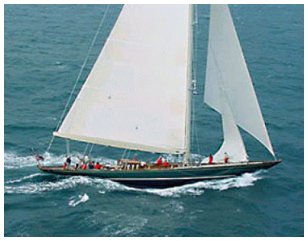 • 1975 : Quadrifoglio undergoes a marine survey and is condemned.
• 1975 : Quadrifoglio undergoes a marine survey and is condemned.
• 1978 : Scanu returns the Quadrifoglio to Camper and Nicholson in Gosport*** Southampton yard, UK and she undergoes a comprehensive three year refit. The hull is striped to sandblast and repair the steel frames, she is re planked in teak, fastened in bronze and has new engines, systems and rigging installed. The work is completed under the supervision of Paolo Scanu, naval architect and son of the owner.
Camper and Nicholson sells their shipyard to Southampton Yacht Service and the main jetty at the yard is named Shamrock Quay in her honor.
• 1981 : Quadrifoglio is relaunched at Southampton Yacht Services.
• 1985 : The Lipton Tea company purchase Quadrifoglio and donates her to the Museum of Yachting in Newport, RI. USA. The Museum reinstates her original name. After almost fifty years she is once again, Shamrock V.
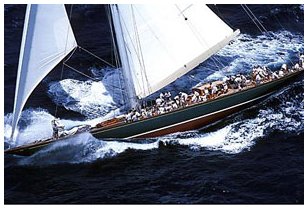 • 1988 : Classic yacht restorer and yachtswoman, Elizabeth Meyers, supervises an extensive refit of Shamrock at Narragansett Shipwrights in Rhode Island. The bulwarks and superstructures added by Crespi are removed and the shear line and deck profile are returned to the original.
• 1988 : Classic yacht restorer and yachtswoman, Elizabeth Meyers, supervises an extensive refit of Shamrock at Narragansett Shipwrights in Rhode Island. The bulwarks and superstructures added by Crespi are removed and the shear line and deck profile are returned to the original.
• 1989 : In a hugely anticipated meeting, Shamrock V and Endeavor race one another over the original America's Cup course in the waters of Narragansett Bay.
• 1995 : The International Yacht Restoration School purchases Shamrock to increase their already impressive collection of classics and names her the school's flagship.
• 1998 : Shamrock is sold to a South American financier. He enters her in the Antigua Classic Yacht Regatta and wins both the event, beating Endevour and Velsheda, and the Course d' Elegance. It is the first time in five decades that more than two J-Class yachts have competed in an event. A new age of J-Class yachting is in the offing.
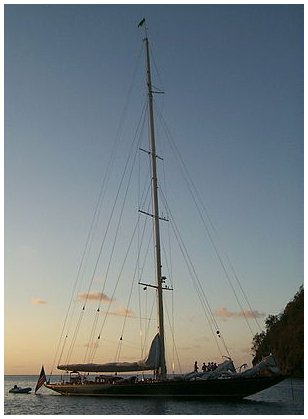 • 1999 : Shamrock sails across the Atlantic and undergoes a complete refit supervised by naval architect, Gerard Dykstra, at Pendennis Shipyard in Falmouth, UK. Without compromising her historical authenticity her performance is enhanced by the addition of a new rig, sails and an improved ballast ratio. The internal layout was improved and the original bird's eye maple panelling was painstakingly incorporated into the new interior joinery.
• 1999 : Shamrock sails across the Atlantic and undergoes a complete refit supervised by naval architect, Gerard Dykstra, at Pendennis Shipyard in Falmouth, UK. Without compromising her historical authenticity her performance is enhanced by the addition of a new rig, sails and an improved ballast ratio. The internal layout was improved and the original bird's eye maple panelling was painstakingly incorporated into the new interior joinery.
In accordance with standards set forth by the American Burea of Shipping her steel work was ultra sounded and improved upon or replaced where found wanting.
• 2001 : Shamrock V is relaunched to wide acclaim. She joins Endeavor and Velsheda in the Lymington Cup Regatta on Christchurch Bay off Lymington, UK. It is the first J-Class event held on British waters in sixty five years.
In August she is the star attraction in the 150th America's Cup Jubilee Celebration at Cowes, Isle of Wight. UK.
• 2001 : Shamrock sails across the Atlantic to compete again in the Antigua Classic Yacht Regatta. She sails back to the Mediterranean.
• 2003 : Shamrock goes by ship from Palma, Spain to New Zealand to attend the America's Cup as an honoree.
• 2005 : Shamrock sails back across the Pacific returning to the Mediterraneanand competes in the seventh Monaco Classic Yacht Regatta.
• 2008-2011 : Shamrock sails annually in the Regates Royale in Cannes France and Les Voiles de St. Tropez. Throughout this period she cruises the waters of the Mediterranean from Spain to Turkey and winters in Cannes.

*** Thank you BRIAN for your correction :
Dear Sir, reading in your “long story of Shamrock V” you have said Shamrock was refitted in 1978 in Camper and Nicholson’s Gosport yard, her re-fit was carried out in fact at Camper and Nicholson’s Southampton yard not Gosport, I worked on shamrock all the time she was at the Southampton(Northam)yard from when she was completely stripped down and re-planked, had a new 90+ lead keel made in a mould and right through to her conclusion in Southampton docks where her new mast was stepped.
Yours sincerely Brian J Smith
